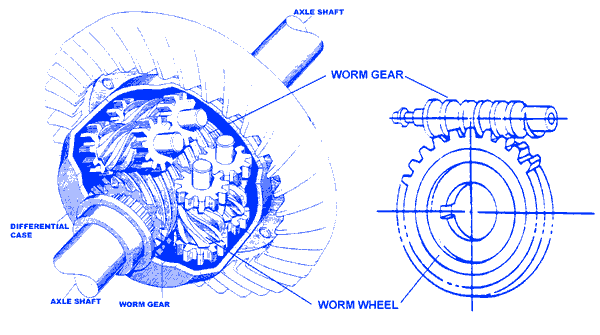

How
the TORSEN Works
The
gear configuration of the "Gleason TORSEN" Differential is unique but
applies the basic engineering principle of the worm to worm wheel relationship.
This principle states that the worm is capable of turning the worm wheel but
this relationship cannot be reversed. Keeping this principle in mind, this is
how the "TORSEN'" Differential works.
Power
is transferred from the engine to the differential housing through gear sets
(ring and pinion or helical gears) causing the housing to rotate. This power
flows through the housing to the worm wheels which are attached to it. These
worm wheels are in mesh with the worm gears attached to the axles causing the
axles to turn with the housing.
What
makes the "TORSEN'" Differential unique is that it has taken the two primary
functions of a differential - differential action and torque distribution - and
made them independent of one another. This allows both differentiation and the
effective allocation of torque in all traction and turning situations, without
sacrificing one for the other.
Condition 1
- DIFFERENTIAL ACTION
When
cornering, the outside wheel of the driven axle, initiated‑‑by the
rolling engagement of the wheels to the road, must increase its RPM level
relative to the differential housing. At the same time the inside wheel must
decrease its RPM level in the same proportion (e.g. outside wheel +4 RPM, inside
wheel - 4 RPM). The worm attached to the outside axle will increase its RPM
level relative to the differential housing, thus the worm will turn its mating
worm wheel. The worm attached to the inside axle will decrease its RPM level
relative to the differential housing, in the same proportion as the outside
wheel is increasing its RPM level and will also rotate its mating worm wheel.
The two worm wheels in the "TORSEN" Differential are in mesh with each
other through the spur gears on a one-to-one relationship and act as balancing
gears to maintain perfect differentiation while maintaining torque to both
wheels.
Condition 2 - TRACTION LOSS BY ONE WHEEL
When
a condition is encountered where one wheel on the driven axle has less traction
than the other wheel, a conventional differential will allow the wheel with the
least traction to spin or increase its RPM level relative to the opposite wheel.
Unlike conventional differentials, the "TORSEN" prevents the wheel
with a loss of traction from spinning. This is how it works. The worm attached
to the axle half shaft of the wheel that wants to spin would increase its RPM
level with the spinning wheel. This worm would then turn its mating worm wheel.
The worm wheel is in mesh with an opposite worm wheel through the spur teeth end
will try to cause this worm wheel to turn. However, this worm wheel is in mesh
with a worm which is attached to an axle and a wheel with good traction. This
worm will not want to rotate or increase its RPM level since it is attached to
the axle with good traction. Since the worm wheel cannot drive the worm, this
worm causes the entire spinning process not to occur so that the opposite wheel
with a loss of traction will not spin. Torque is distributed to both wheels in
proportion to the traction available at each wheel.
Condition 3 - TRACTION LOSS BY ONE WHEEL WHILE IN A TURN
When
a condition is encountered where one wheel on the driven axle has less traction
than the other wheel while cornering, a conventional or limited slip
differential will allow the wheel with the least traction to spin or increase
its RPM level relative to the opposite wheel beyond what is dictated by
differential action. The "TORSEN'" prevents the wheel with a loss of
traction from spinning. This is how it works. Differential action will occur as
described in Condition 1. The wheel with a loss of traction will be prevented
from increasing its RPM level beyond what is dictated by differential action by
the principles described in Condition 2.
In the Torsen, as in any other differential, the power of the engine is transferred to the differential housing via the ring gear. The Torsen then uses pairs of worm wheels (from two to three pairs, depending on the size of the differential) mounted on the differential housing to turn the worm gears splined to the axle shafts. The left worm wheel of each pair turns the left axle shaft, and the right worm wheel of each pair turns the right axle shaft. Because the worm wheel cannot turn the worm gear, it locks on the gear and turns the axle shaft. propelling the vehicle forward. The right and left axle shafts (and right and left wheels) turn simultaneously. Each wheel then rotates at the same speed. However, when the vehicle makes a turn, each wheel rotates at a slightly different rpm. For instance, during a left turn. the left wheel will slow down by two rpm, and the right wheel will speed up by two rpm. One axle shaft always slows down at the exact rate that the other one speeds up. This difference in rpm is transferred to the worm wheels (because the worm gear on the axle shaft can turn the worm wheel and equalize the other side via the 1:1 spur gears. which act as balancing gears). So the engine is "locked" or engaged on the axle shafts, while allowing for differential action when negotiating turns.
